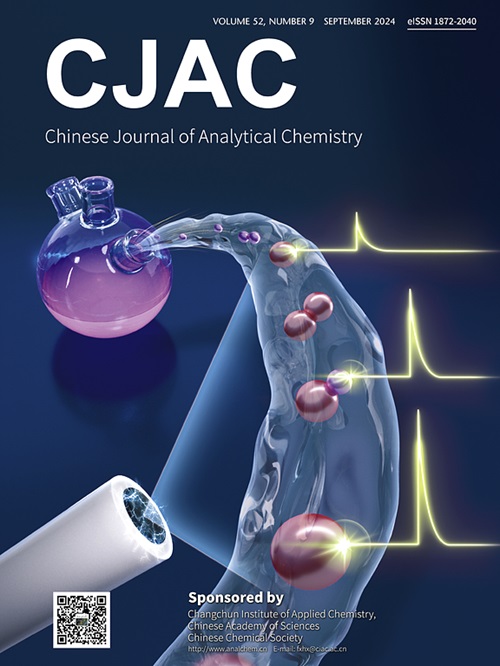Hydrothermally tailored hematite nanorods for photo-fenton degradation of 4-nitrophenol: Influence of morphology on catalytic mechanism and environmental safety
IF 1.3
4区 化学
Q4 CHEMISTRY, ANALYTICAL
引用次数: 0
Abstract
Hematite rod nanoparticles were synthesized by alkaline hydrothermal modification of natural laterite for different durations (12, 24, 36, and 48 h). The impact of the modification duration on the morphology and physicochemical properties of the resulting modified varieties of hematite (H.12, H.25, H.36, and H.48) was assessed using different analytic techniques. The four derivatives were applied as potential catalysts during the decontamination of hazardous 4-nitrophenol (4-NP) by photo-Fenton’s oxidation. The modified H.36 displayed the best geometry as nanorods, the highest surface area (154.7 m2/g), and the most effective catalytic performances. The incorporation of H.36 at a dose of 0.4 g/L resulted in complete oxidation for the investigated 4-nitrophenol contaminants within 80 min (5 mg/L), 120 min (10 mg/L), and 180 min (15 mg/L). The mineralization studies validated the successful transformation of 4-NP molecules (5 mg/L) into safe end products over H.36 within 160 min. The mineralization pathway ended by the formation of H2O, CO2, NO2−, and NO3− after a series of oxidation reactions involved interaction with the release of hydroxyl radicals and generation of different intermediaries (p-benzoquinone, hydroquinone, 4-aminophenol, and acetic acid). The eco-toxicity studies for the treated solutions over different durations, considering both chronic (ChV > 10) and acute toxicity (LC50 and EC50 > 100), signify remarkable impact for the applied oxidation reactions using H.36 in reducing the toxicity of 4-NP and inducing the safety of the treated samples, especially after 160 min.

水热定制赤铁矿纳米棒用于光fenton降解4-硝基苯酚:形态对催化机理和环境安全性的影响
以天然红土为原料,经不同时间(12、24、36、48 h)的碱性水热改性,合成了纳米赤铁矿棒。采用不同的分析技术,考察了改性时间对改性后赤铁矿H.12、H.25、H.36和H.48的形态和理化性质的影响。将这四种衍生物作为潜在的催化剂应用于光- fenton氧化法净化有害的4-硝基苯酚(4-NP)。改性后的H.36具有最佳的纳米棒几何形状、最高的比表面积(154.7 m2/g)和最有效的催化性能。在0.4 g/L的浓度下,H.36在80 min (5 mg/L)、120 min (10 mg/L)和180 min (15 mg/L)内完全氧化所研究的4-硝基酚污染物。矿化研究证实了4-NP分子(5mg /L)在160分钟内通过H.36转化为安全的最终产物。矿化途径通过一系列氧化反应,包括羟基自由基的释放和不同中间体(对苯醌、对苯二酚、4-氨基酚和乙酸)的生成,最终形成H2O、CO2、NO2−和NO3−。考虑到慢性毒性(ChV > 10)和急性毒性(LC50和EC50 >; 100),不同时间处理溶液的生态毒性研究表明,使用H.36的氧化反应在降低4-NP的毒性和诱导处理样品的安全性方面有显著影响,特别是在160分钟后。
本文章由计算机程序翻译,如有差异,请以英文原文为准。
求助全文
约1分钟内获得全文
求助全文
来源期刊
CiteScore
3.60
自引率
25.00%
发文量
17223
审稿时长
35 days
期刊介绍:
Chinese Journal of Analytical Chemistry(CJAC) is an academic journal of analytical chemistry established in 1972 and sponsored by the Chinese Chemical Society and Changchun Institute of Applied Chemistry, Chinese Academy of Sciences. Its objectives are to report the original scientific research achievements and review the recent development of analytical chemistry in all areas. The journal sets up 5 columns including Research Papers, Research Notes, Experimental Technique and Instrument, Review and Progress and Summary Accounts. The journal published monthly in Chinese language. A detailed abstract, keywords and the titles of figures and tables are provided in English, except column of Summary Accounts. Prof. Wang Erkang, an outstanding analytical chemist, academician of Chinese Academy of Sciences & Third World Academy of Sciences, holds the post of the Editor-in-chief.

 求助内容:
求助内容: 应助结果提醒方式:
应助结果提醒方式:


